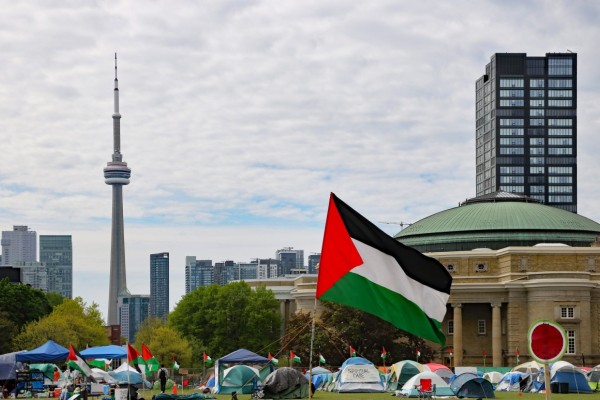From Apathy to Activism
Student activists lead the way in building cross-campus, cross-movement coalitions
Why is it that students don’t really give a damn about anything outside their own lives?” asks Mikhael Aziz. An upper-year undergraduate student at York University, Aziz is also a member of Students Against Israeli Apartheid, a group at the forefront of campus mobilization.
Regarding the deeply rooted apathy that many students exhibit, my observation, and that of those with whom I have consulted in writing this article, is that it is an offshoot of a sense of self-entitlement. Most students have yet to experience any political upheaval or economic hardship for themselves. The wave of relatively steady economic growth in Canada, and the consumer culture that accompanies it, results in a dangerous combination of political complacency and consumer insatiability. Coupled with the demolishment of the welfare state, the resulting competitive individualism produces a sense of hostility expressed as self-entitlement, which has had a potent demobilizing effect across campuses nationwide.
Commenting on the nature of indoctrination that paralyzes the creative engagement and politicization of students, critical pedagogue and University of Ottawa physics professor Denis Rancourt indicts the post-secondary education system with inspired vigour. He says that, if the student’s only goal is to get the “piece of paper” that will help to find a job, then that student has already bought into the system. Once on board in this fashion, it is easy to avoid becoming politicized, because, as Rancourt points out, “you’re in the heart of the machine that indoctrinates you. It is a very, very difficult, challenging, sterile environment. You’re in the heart of the beast.”
Still, as I’ll describe, student politics is beginning to stir, despite the toxic conditions.
Grade Inflation and a Bad Education
A predictable corollary to the culture of self-entitlement is the matter of grade inflation, be it real or perceived. At the end of each term, university administrators fear an onslaught of enraged students, as the burden of ever-rising tuition translates into violent outbursts, with students demanding that they “get what they paid for.” The crude reality of higher education comes home to roost in all its ugliness, as teaching assistants and faculty are told to aim for the magical C+ average in their classes. The main objective: retention. A secondary benefit: avoiding conflict. As a consequence, there is much lip service being paid to quality education, but more and more students know better.
When Aziz asked one of his political science professors why so many undergraduate courses have been cancelled, the professor explains that the university is “experiencing a budget crisis.” The perpetual “budget crisis” is a favourite crutch that university administrators like to lean on – selectively, of course. There is (public) funding in abundance for security staff, sleek advertising campaigns and salary raises for university executives, but it is a “budget crisis” that keeps universities from spending on anything that could promote quality education. Bridging the gap between the university’s dastardly spending habits and the complete alienation of students is the disconcerting promise of at least a passing grade.
As she reflects on the university’s mandate to produce critical thinkers and its actions that promote the contrary, poet and York University sociology professor Himani Bannerji poignantly asks, “How can I blame the students for our inability to prepare them?” With reference to the obstacles she faces teaching a third-year “Racism and Culture” summer course, she makes this disconnect between the university’s rhetoric and the reality of the situation abundantly clear. At a time when graduate students are starved for meaningful work in the form of teaching assistantships, Bannerji is refused any such help by the university, which leaves her to manage sixty students on her own.
Caught in the middle of this ludicrous mishandling of resources are the students. Surely they would receive a better-quality education with an opportunity to engage with this complex material in smaller discussion groups, rather than in a sixty-person classroom. Yet, as Bannerji remarks, “They’re being asked to pay more, get less support and services, and we are being overburdened in the classroom with these huge classes.” On top of it all, the expectation of a passing grade from both the university and the students squeezes every last ounce of integrity out of the education system as a whole. Rubber stamps and red tape abound, and higher education is quickly becoming a farce.
Security and Regulation-Induced Rigor Mortis
In addition to the grading front, the battle for quality education has another foe in the university’s more directly repressive tactics. The increase in campus security measures, including nothing less than cameras in classrooms (let alone in the atriums), renders toxic what should be an atmosphere of open, critical inquiry. Like dour, over-posturing Wal-Mart greeters of the university campus, it is even common to have security guards in bullet-proof vests cross your path on the way to class.
In terms of the specific components of the university’s armoury that proficiently entrench apathy, there is the Code of Conduct. Administrators like to fatten these codes with more and more restrictions and procedures, which keeps students and faculty busy gnawing away on a mess of rules. Those that do open their mouths are punished with defamation suits and expulsions, with the desire to speak out being further extinguished by the swiftly moving legal apparatus that universities have at their disposal. Mincing no words, Bannerji observes that “student activism on the campus has been definitely dampened by the university’s administration getting stronger and stronger.” With reference to the university’s “arbitrary rules of arrest and detention,” she explains that the resultant atmosphere on campuses “is one of intimidation.”
Those that participated in a March 20 sit-in outside a University Affairs Board meeting on the University of Toronto campus are feeling the full weight of these measures. This action was taken to protest a residence-fee hike, and it ended with several participants being forcefully removed from their position outside the meeting by police and campus security. Accused of violating the university’s Code of Student Conduct, fourteen sit-in participants now face charges and restrictive bail conditions (for more information, please see the article by Noaman Ali in this issue).
As the U of T case points out, university administrators have a full arsenal of regulatory measures that they like to unleash – and often on the sly, in the summer or around exam time, when students are dispersed and not easily organized.
Student Re-Engagement
In spite of the university’s repressive administrative structure, Bannerji is “surprised and pleased” that some students do insist on mounting some resistance, but is careful to point out that they do so at greater personal risk. “We are no longer thinking students will be students; we are thinking of them as criminals in training,” she adds, describing how university administrators interpret student engagement. Emilie Connolly, an upper-year undergraduate student at McGill and co-editor of Praxis, a new student journal, offers similar foresight on the effects of more stringent codes and security measures, noting that, “as universities start to clamp down on more recognizable forms of student activism, they start to get pushed to the margins.” By these accounts, it is the marginalization, if not criminalization, of student activism that makes even moderately engaged students feel at risk, an ideal situation from the university’s perspective. To a degree, however, it seems that the repressive tactics of university administrators may function to strengthen certain students’ resolve, encouraging them to revisit their own strategies of mobilization.
Similar to Students Against Israeli Apartheid, the student branch of No One is Illegal is a standout group that seeks to fight intimidation by promoting linkages across campuses and movements. At a March, 2008 rally on the York University campus, faculty and students from the University of Toronto and Ryerson gathered to protest the deportation of York student Sarah (Saint-Sierra) Leonty. With the help of this vocal network of support, Leonty was granted a two-year stay in Canada. These types of actions suggest that the political sterility that plagues any one campus can be circumvented by forging new, cross-campus coalitions of determined students, who work alongside members of the community to generate momentum.
The seeds of student re-engagement have also been planted in the unlikeliest places. “The University of Ottawa traditionally was called ‘Apathy U’ by the students,” says Rancourt. “Now it’s becoming a powerhouse as an activist centre.” Firmly anarchist in his approach, his prescription for sustaining momentum and confronting intimidation focuses on a “diversity of tactics,” which includes recognizing “that some people are willing to go further and take more risks, and you protect them, you back them.”
What is emerging is a focus on coalition building and cross-movement solidarity. With resource and knowledge sharing as the objective, trade unions and Aboriginal, anti-poverty and anti-imperialist groups of all varieties are joining together. “This may be the time for that kind of politics, because all kinds of groups are under attack, and the economy is in crisis. New adjustments have to be made, so maybe we are heading towards a coalition kind of politics,” says Bannerji.
Connolly provides an analogous overview, highlighting how this is already central to campus organizing. She notes that, “at McGill, there is a lot of established infrastructure of politics, but there is a lot of disenchantment with those kinds of politics. There are a lot of more grassroots organizations on [both the McGill and Concordia] campuses, and a lot of coalitions of on-campus groups with off-campus groups being built right now that are pretty exciting.” Given the state of disengagement on campuses, such coalitions become the key avenues of resistance, providing a network of support that no single campus movement is yet able to promise.
Looking Ahead
Recent sit-ins at the University of Toronto and York University protesting fee hikes and the use of sweatshop labour; teaching-assistant strikes at McGill and McMaster; a rally at the University of British Columbia to protect vital campus green space – all these actions represent only a fraction of the organizing taking place on campuses today. What is vital to the success of these actions is the way in which they are all linked across campuses and across causes, bringing student groups alongside labour unions, war resisters, and so on. Students in particular, with their more variable schedules and larger numbers, have a critical role to play in supporting other movements with a marked physical presence on off-campus picket lines, demonstrations and land-reclamation sites.
This renewal of political engagement on campuses across Canada demonstrates a changing tide in which movements are fusing together, and students are slipping out from under the university’s thumb to find their voices intact, ready to enact change. In many respects, student organizing is at the forefront of battles that the broader society is going to have to face in the not-so-distant future.
This article appeared in the September/October 2008 issue of Canadian Dimension (Canadian Students).










